SAILING IN FRENCH POLYNESIA
Although French Polynesia is one country, it is comprised of four archipelagos spread across 1.5 million square miles of the Pacific Ocean. So getting from one archipelago to another can entail many miles of sailing.
We made landfall in French Polynesia in the Marquesas. From there, we sailed 540 miles to the Tuamotus over four days. From the Tuamotus we sailed 290 miles to the Society Islands over two days. French Polynesia and her various island groups are discussed as destinations. This page chronicles our sails between those groups within French Polynesia.
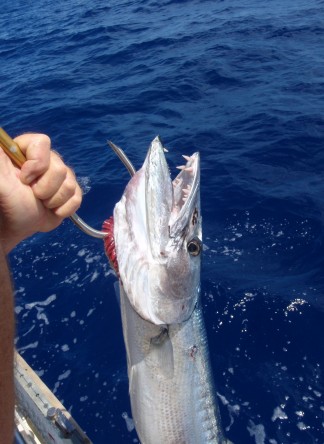
It was a brilliant night. There was a meteor shower above and lots of bioluminescence in the water. There was so much starlight that it looked like there was moonlight long after the moon had set. The winds increased, so we furled the staysail and reefed the jib. We had a good sail through the night.
On our second day, we were out of the shadow of the islands. The winds increased to 15 to 18 knots then settled around 12. We were sailing with a single reef in the main, 75% of the #2, and the staysail. The seas increased to 4 to 5 feet with mild chop then settled. We furled the staysail and let out the full #2 for a perfect beam reach in nearly flat seas for most of the afternoon. During the night, the winds decreased slightly and backed putting us on a broad reach. We had lost our positive current, and a mild current of 0.2 knots had developed against us. The winds were light through another night of stars, starlight, and meteors.
Our third day started with light air – 9 to 10 knots – as predicted. We sailed with a full main and #2 while trying to maintain 6 knots of boat speed. We caught a big barracuda, and we threw it back and reset our fishing gear. We had a few small squalls blow over with 22 knots of wind, rain, and bumpy seas. After the squalls passed, we had 14 to 19 knots of wind, but the seas remained bumpy. We sailed on with a double reefed main, 50% of the #2, and a staysail. We had caught a tuna sometime during the squalls, but we were busy with sails, so he had to wait. The poor thing was a bit beaten up by the time we got around to dragging him in. Squalls resumed with winds to 27 knots, and the seas were miserable. Neither of us got much sleep that night.
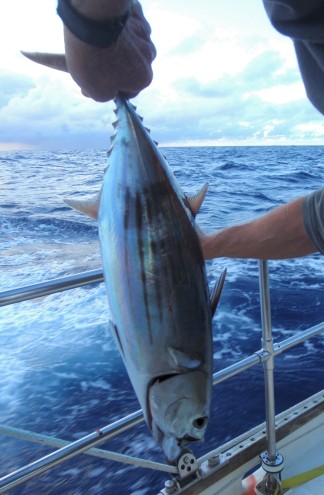
Tuna

Our fourth day dawned with 100% cloud cover and many squalls until around 0900 local time. The seas were very choppy and rolly. By afternoon the wind decreased to 15 to 17 knots, and we sailed with a double reefed main and 50% of the #2 jib. We needed to slow down so that we would not arrive before dawn the next morning. We had one half knot of current against us, but we were still going too fast. We reduced our jib to just a small scrap, and we made 3 to 4 knots of boat speed with winds of 13 to 17 knots through the night.
We arrived at the southeast corner of Kauehi’s atoll at sunrise. We continued toward the pass at our snail’s pace of 3 to 4 knots as we waited for the sun to rise a bit higher so that we could see the reef as we entered the lagoon. We were going a bit faster than we wanted, so we reduced sail to only a double reefed main. We were going sloooow.
We arrived at the pass at 0945 local time. We could see that a moderate current was running outward. It is a fairly wide pass, so we decided to try to enter against the current. If the current was too much, we could simply drift back out with it. Once in the pass, we found that the current was stronger than we expected. At one point it was 3.5 knots against us, and our speed over ground was less than 2 knots. But we made it through without problems.
Once inside the lagoon, we had to motorsail seven miles across to Kauehi’s only village of Tearavero. It was deep until we were close in. We had planned to arrive close to midday so that we would have the sun well overhead and we could see the bommies, and our timing was perfect. There are many bommies, but we had excellent visibility. We circled a bit until we found our spot in 27’ of gin clear water. We anchored just after noon local time.
We had made serious efforts to slow down for our last 24 hours out, and we still made ok time. Even with our intentional slowing, we traveled 540 miles in 93 ½ hours for an average of 5.8 knots per hour.
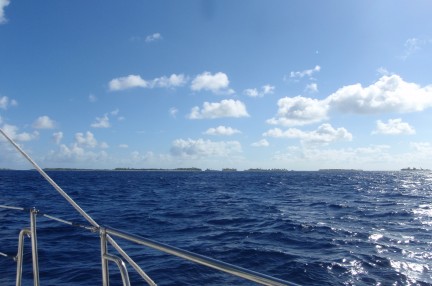
Approaching the low-lying atoll of Kauehi, Tuamotus
And we did not see another vessel along the way. One ship came up on our AIS on our second night out, but we did not see her. And we saw nothing else visually, on radar, or on AIS. This route is often called ‘the coconut milk run’ because it is such a common route among cruisers. However, there were no other vessels out there within our range of detection.
We have now sailed 6,174 miles this season. We still have one short passage to make – Tuamotus to Society Islands. We are looking forward to being done with passages for this season.
Come with us to the Tuamotus.
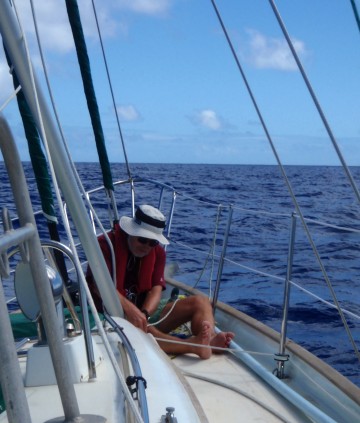
Rigging the pole – again…
On Sunday, August 17, the winds were inconsistent in strength and irregular in direction all day. The wind varied from 5 to 15 knots from all directions. We were able to sail wing-and-wing for a while in the morning, but we were mostly motorsailing and already getting tired of it. We had a few squalls in the afternoon, and the winds never were above 19 knots. We had a nice rain for about an hour. Then overnight the winds were only 7 to 11 knots, and they were dead aft – just enough to blow our exhaust fumes in to the cockpit as we motorsailed through the night.
We started having fuel problems again during our second night. The engine would race a bit – the same problem we had during our passage from Galapagos to the Marquesas.
On Monday, August 18, we were approaching Tahiti as the sun rose. We continued to motorsail, and our fuel problem persisted. We did get one strike on our fishing gear, but we did not get the fish. We would remain fishless on this passage.
We entered Papeete Pass directly off the town of Papeete. However, sailboats are no longer allowed to anchor or moor there, so we headed down the northwest coast. We had to call Papeete Airport Control to get clearance to pass both ends of the airport runway. Planes come in so low that there is a collision risk with sailboats. Then as we were approaching the anchorage, an outrigger maneuvered himself right behind us and was slipstreaming in our stern wake. It was fun to see, and he enjoyed the free ride.
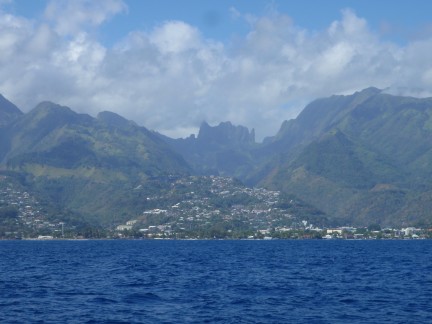
Approaching Tahiti
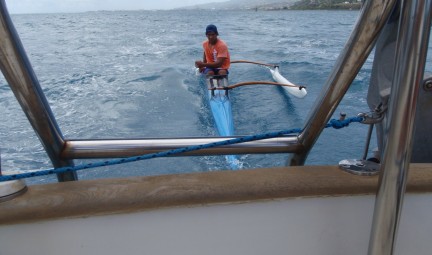
Kayaker riding our wake
We found the anchorage quite crowded, but we looked around for a spot for a few minutes. But our fuel issue was suddenly worsening, so we decided to go across to the mooring field and pick up a mooring. Just as we were picking up the mooring pennant, our engine died. Fortunately we got the mooring pennant on our first pass, because we had no way to come back up to it for a second try. And it is 60’ deep in this part of the anchorage, so it would have taken some time to get an anchor down. We got lucky again.
We will remember this passage for the almost constant motorsailing and slatting sails. We have not motorsailed this much since we left the Mediterranean. Fortunately, it was a relatively brief passage.
We covered 290 miles in 52 hours 10 minutes. That is an average speed of only 5.6 knots per hour. That is slow for us, but it was ok considering that we motorsailed at least two thirds of the way. Now we must investigate this fuel issue.
Come with us to the Society Islands.